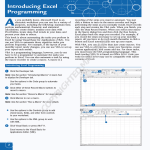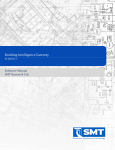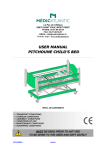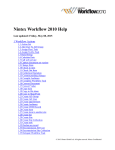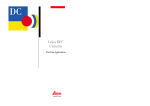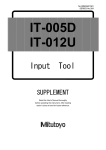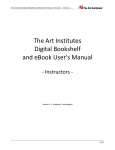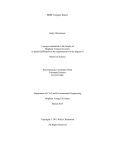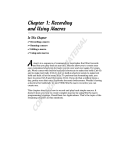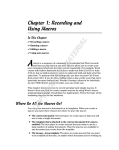Download Wiley Microsoft Office Excel 2007 Programming: Your visual blueprint for creating interactive spreadsheets
Transcript
Introducing Excel Programming A s you probably know, Microsoft Excel is an electronic worksheet you can use for a variety of purposes, including the following: maintain lists; perform mathematical, financial, and statistical calculations; create charts; and analyze your data with a PivotTable. Excel can also help you locate data, find trends in your data, and present your data to others. AL This book is about automating the tasks you perform in Excel by using Visual Basic for Applications (VBA). You can use VBA to automate those repetitive tasks you perform frequently. For example, if the layout of your monthly report rarely changes, you can use VBA to set up your report each month. TE RI With VBA, you can do more that just create macros. You can use VBA to edit macros, create new functions, create custom applications, and create add-ins. For these tasks, you must learn the VBA programming language. This book teaches VBA. It is based on Office 2007; code you write for Office 2007 may not be compatible with earlier versions of Excel. MA VBA is a programming language; however, you do not have to be a programmer to automate the tasks you perform in Excel. You can also automate a task by using the macro recorder to create a macro. A macro is a 1 D Introducing Excel Programming Click the Developer tab. TE 1 recording of the steps you want to automate. You just click a button to turn on the macro recorder and begin performing the steps as you normally would. Excel records each step and creates the VBA code. When you finish, you click the Stop Record button. When you select your macro in the Macro dialog box and click the Run button, Excel plays back the steps you recorded. For example, if you record the steps necessary to create your monthly report, all you have to do each month thereafter is click a button and Excel automatically sets up your report. GH Note: See the section, “Introducing Macros,” to learn how to display the Developer tab. Use the options in the Code group to automate your tasks. Click either of these Record Macro buttons to record a macro. RI 2 3 3 Click Macros to run a macro. PY Note: See the section, “Record a Macro,” for more details. 2 CO Note: See the section, “Run a Macro,” for more details. • Use the options in the Controls group to add check boxes, fields, and other form controls to your worksheet. • Use the options in the XML group to work with XML. 4 Click here or press Alt+F11. Excel moves to the Visual Basic for Applications Editor (VBE). 2 4 2 Note: See Chapter 2 to learn more about the VBE. 5 Click the proper module to access your macros or the VBA code you have written. 6 Type or edit your code here. 7 Press Alt+F11 to return to Excel. 5 6 The VBA returns you to Excel. Chapter 1: Using Macros and Form Controls Use the VBE to write and edit code. You can also use Microsoft Visual Studio Tools for the Microsoft Office System (Visual Studio) to develop programs for Microsoft Office products. With Visual Studio, you can write in languages such as Visual Basic .NET, Visual C#, and Managed Extensions for C++. Visual Studio is not part of Microsoft Office; you must purchase it. Microsoft supports both VBA and Visual Studio. Visual Studio is more difficult to learn than VBA and setting up and using Visual Studio is much more difficult than setting up and using VBA. However, Visual Studio offers better security, a more sophisticated development environment, and built-in Web services. 3 Introducing Macros Record Macro dialog box, see the section, “Record a Macro.” Y ou can use macros to automate many of the tasks you perform in Excel. For example, if you frequently format your data in a particular way, you can use Excel’s macro recorder to record the steps you use to format your data. You can then play back the recorded steps whenever you want to apply your format. Any series of commands you can execute in Excel, you can also record and play back. When you record a macro, you can record it using an absolute reference or a relative reference. If you record using an absolute reference, when Excel plays back your macro, it plays back the exact cells you clicked when you recorded the macro. If you record using a relative reference, Excel plays back the relative location of the cells you used when you recorded your macro. Click the Use Relative References button on the Developer tab to record using a relative reference. To learn more about absolute and relative references, see the section, “Record a Macro.” The commands you use to create and execute macros are located on the Developer tab. By default, the Developer tab does not display in Excel. To display it, you must choose the Show Developer Tab in the Ribbon option in the Excel Options dialog box. You begin recording macros by clicking Record Macro on the Developer tab or by clicking the Record Macro button on the status bar. Both commands open the Record Macro dialog box. For detailed instructions on how to use the When you save a workbook that has macros, you must save it as a macro-enabled workbook. Excel gives macroenabled workbooks an .xlsm file extension. Introducing Macros 1 SHOW THE DEVELOPER TAB 1 Click Customize Quick Access Toolbar and then click More Commands. The Excel Options dialog box appears. 2 Click Popular. 3 Click Show Developer Tab in the Ribbon ( 4 Click OK. 1 changes to ). The Developer tab appears in the Ribbon. • • • • • Click to record a macro. Click to record with a relative reference. Click to change macro security. Click to run macros. Click to open the Visual Basic Editor. 2 3 4 4 1 Click the Microsoft Office button. A menu appears. 2 1 2 Click Save As ➔ Excel Macro-Enabled Workbook. The Save As dialog box appears. 3 4 5 Click here and then select the folder in which you want to save your workbook. Type the name you want to give your workbook. Click Save. 3 Excel saves your workbook as a macro-enabled workbook. 4 Because of problems with macro viruses, Excel disables all macros by default when you open a workbook. You can click the Macro Security button on the Developer tab to change the default setting. To learn more about macro security, see the sections, “Set Macro Security,” “Create a Digital Signature,” and “Assign a Digital Signature to a Macro.” If you have programming experience or aptitude, you can edit Excel macros by using the Visual Basic Editor, which is available by pressing the Visual Basic button on the Developer tab. Chapter 1: Using Macros and Form Controls SAVE A WORKBOOK 5 You can use the Macro dialog box to run a macro. To open the Macro dialog box, click the Macro button on the Developer tab, press Alt+F8, or place the View Macros button on the Quick Access toolbar. To place the View Macros button on the Quick Access toolbar, click the Microsoft Office button, and then click Excel Options. The Excel Options dialog box appears. Click Customize. The Customize the Quick Access Toolbar pane appears. In the Choose Commands From field, choose Popular Commands and then click View Macros. Click the Add Button. Click OK. The View Macros button appears on the Quick Access toolbar. 5 Set Macro Security publisher has digitally signed the macro but you have not opted to trust the publisher, you can enable the macro or trust the publisher. See the “Extra” information in the section, “Run a Macro,” to learn how to trust a publisher. B ecause of increasing problems with computer viruses, specifically macro viruses, the default Excel macro security setting disables all macros when you open a workbook, and allows you to decide on a case-by-case basis whether you want to enable them. This is true whether you created the macros or someone else created them. You can change the Excel macro security setting. Excel provides four options: • Disable all macros without notification: This option disables all macros and does not provide you with any security alerts to let you know macros exist. • Disable all macros with notification: This is the default setting. It notifies you if macros are present so you can enable them on a case-by-case basis. • Disable all macros except digitally signed macros: This option disables all macros except those digitally signed by a trusted publisher. If the • Enable all macros (not recommended; potentially dangerous code can run): This option allows you to run all macros. Because potentially dangerous code can run, Microsoft does not recommend this option. Changes you make to macro security in Excel do not change the macro security in other Office programs. Macro creators use digital signatures to verify the safety of the macros they create. You can create your own digital signature by using the Microsoft Selfcert.exe tool, or you can obtain a digital certificate from a commercial certificate of authority vendor. For more information on the Microsoft Selfcert.exe tool, see the next section, “Create a Digital Signature.” Set Macro Security 1 1 Click the Developer tab. Note: See the section, “Introducing Macros,” to learn how to display the Developer tab. 2 2 Click Macro Security in the Code group. The Trust Center dialog box appears. 3 Click to select a macro setting ( 4 Click OK. changes to ). 3 Excel changes your macro security setting. 4 6 f you create a workbook that contains macros, you should consider using a digital signature. A digital signature provides assurance that the workbook file is valid and no one has altered it. You can create a personal digital signature by using the Microsoft Selfcert.exe tool. Projects signed with digital signatures created with the Selfcert.exe tool only work on computers that have the certificate in their Personal Certificates store. someone has changed the macro and therefore the macro should not be trusted. Digital signatures that you create with the SelfCert.exe tool work well for personal workbooks; however, if you plan to distribute your workbook to users outside your workgroup, you should consider acquiring a commercial digital signature file. When you use a commercial digital signature file, the digital ID attaches to the macro and remains with it; if anyone alters the macro, Excel notifies the user that To view the certificates in your Personal Certificate store, open Internet Explorer. On the Internet Explorer menu, click Tools and then click Internet Options. The Internet Options dialog box appears. Click the Content tab. Click the Certificates button. The Certificates dialog box appears. Click the Personal tab. All of your personal certificates appear. I The most common provider of commercial digital certification is VeriSign, Inc. You can find out more about obtaining a commercial certification from VeriSign at www.verisign.com. Chapter 1: Using Macros and Form Controls Create a Digital Signature Create a Digital Signature 1 2 Click Start. Click All Programs ➔ Microsoft Office ➔ Microsoft Office Tools ➔ Digital Certificate for VBA Projects. 2 1 The Create Digital Certificate dialog box appears. 3 4 Type the name you want to give your certificate. Click OK. Excel creates a Personal Digital Certificate. 3 4 7 Record a Macro A macro enables you to automate common tasks. You can use a macro to record any series of commands you can execute in Excel. For example, if you frequently apply a certain format to your worksheet, you can record the steps for creating the format and then play them back each time you want to apply the format. Clicking the Macro Recorder button opens the Record Macro dialog box in which you can name your macro, assign your macro to a shortcut key, and tell Excel where you want to store your macro. You can name your macro anything you want, with the following limitations: the name must start with a letter; it can only contain letters, numbers, and underscores; and it cannot contain any spaces. You can assign any uppercase or lowercase letter to act as the shortcut key. In the Record Macro dialog box, the Store Macro In field tells Excel where to store your macro. You can choose to store your macro in the Personal Macro Workbook, a New Workbook, or This Workbook. Use the Personal Macro Workbook option if you want to make your macro available to all Excel files. After you have stored a least one macro in the Personal Macro Workbook, the workbook opens whenever you open an Excel file. Use the New Workbook option if you have specialized macros that you want to use with multiple files. If you store your macro in a new workbook, you can use the macros whenever that workbook is open. Use the This Workbook option if you want your macro to be in the workbook in which you are currently working. Record a Macro 1 Click the Developer tab. 1 2 Note: See the section, “Introducing Macros,” to learn how to display the Developer tab. • Alternatively, click the Record Macro button on the status bar and skip step 2. 2 Click Record Macro in the Code group. The Record Macro dialog box appears. 3 Type the name you want to give your macro. 4 Type the shortcut key you want to assign to your macro. Press Shift as you type to assign an uppercase key. 5 6 Type a description of your macro. 7 Click OK. 8 3 4 5 Click here and then select the workbook in which you want to store your macro. 7 6 8 Perform the steps you want to record. 8 This example changes the number format. 9 • 0 9 Click the Developer tab. Alternatively, click the Stop Recording button on the status bar and skip step 10. 0 Click Stop Recording in the Code group. Excel stops recording your macro. Chapter 1: Using Macros and Form Controls You are now ready to record your macro. Your macro is ready for you to use. Note: See the section, “Run a Macro,” to learn how to run a macro. A macro you create in Excel can have a relative, absolute, or mixed reference. If you use a relative reference, Excel performs the macro based on a relative location. For example, suppose you move up two cells from cell A3 to A1 when creating your macro. When you run your macro, if you are in cell C3, Excel moves up two cells from cell C3 to C1. However, if you use an absolute reference, Excel performs the macro based on the exact cell addresses. For example, suppose again that you move up two cells from cell A3 to A1. When you run your macro, if you are in cell C3, Excel moves from there to the cells you used when you recorded your macro. That is, Excel moves from cell A3 to cell A1. By default, Excel creates macros with an absolute reference. To create a macro with a relative reference, click the Use Relative Reference button on the Developer tab to toggle the relative reference option on. To create a macro with both a relative and an absolute reference — a mixed reference — toggle the Use Relative Reference on and off as needed as you create your macro. 9 Assign a Digital Signature to a Macro A digital signature provides assurance that a workbook file is valid and no one has altered it. There are two types of digital signatures: personal digital signatures and commercial digital signatures. You can create a personal digital signature by using the Microsoft Selfcert.exe tool, or you can purchase a digital signature. Refer to the section, “Create a Digital Signature,” to learn how to create digital signatures. After you create a digital signature, you must attach it to your workbook. Attaching a digital signature is similar to sealing an envelope. If an envelope arrives sealed, you have some level of assurance that no one has tampered with its contents. Use the Digital Signature dialog box to attach a digital signature. The Visual Basic Editor is a separate Excel module that you can use to edit your macro. You access the Digital Signature dialog box by opening the Visual Basic Editor. The Digital Signature dialog box lists valid certificates. You can use the Digital Signature dialog box to view certificates and to select the one you want to use. Unless you have on your computer a valid digital signature certificate for the signature used to sign a macro, Excel removes the digital signature if you modify a macro in a workbook, and you must reattach it. If you are not sure if a workbook has a digital signature, you can check the signature by reviewing the Digital Signature dialog box. If a workbook has a digital signature, the name of the signature appears in the Certificate Name field. If you click the Remove button in the Digital Signature dialog box, Excel removes the digital signature. Assign a Digital Signature to a Macro 1 1 Click the Developer tab. Note: See the section, “Introducing Macros,” to learn how to display the Developer tab. 2 Click Visual Basic in the Code group. The Visual Basic Editor appears. 3 10 2 3 Click Tools ➔ Digital Signature. 4 4 Click Choose. 4 The Select Certificate dialog box appears. Note: See the section, “Create a Digital Signature,” to learn how to create a digital signature. 5 Click the signature you want to apply. 6 Click OK to close the Select Certificate dialog box. 7 Click OK to close the Digital Signature dialog box. Denise E... Excel attaches the digital signature to your workbook. If you have macro security enabled, Excel displays a warning just below the Ribbon when you open a workbook containing a signed macro. You can click the Options button located next to the warning to open the Microsoft Office Security Options dialog box, where you can indicate that you trust the publisher. Excel then saves the name of the publisher in the Trusted Publishers section of the Trust Center. Denise Eth... Code Signing None 1/1/2012 Chapter 1: Using Macros and Form Controls The Digital Signature dialog box appears. 5 6 If you click the Macro Security button on the Developer tab, the Trust Center dialog box appears. Click Trusted Publisher to display a list of your trusted publishers. If you no longer want to trust macros from a publisher listed on the Trusted Publishers page, click the name of the publisher and then click Remove. The next time you open a workbook with a macro from a removed publisher, Excel again warns you about its macros. 7 Unless you have your macro settings set to enable all macros, Excel checks all documents you open for macros. See the section, “Set Macro Security,” for more information. If you have a file that you do not want Excel to check, you can store it in a trusted location. In the Trust Center dialog box, click Trusted Locations to define a trusted location. 11 Run a Macro M acros enable you to perform quickly tasks that would normally take multiple steps. When you run a macro, Excel replays the steps you recorded when you created the macro. You can run any macro located in any workbook as long as the workbook in which the macro is located is open. To run a macro, you can press the shortcut key you assigned when you created the macro or you can select the macro from the Macro dialog box. When you create a macro, you can choose to store it in one of three locations: the current workbook, a new workbook, or the Personal Macro Workbook. By default, the Macro dialog box lists all of the macros in open workbooks. If a macro is stored in the Personal Macro Workbook, the workbook opens as a hidden file each time you open a file. By default, the macros in the Personal Macro Workbook always appear in the Macro dialog box. You can use the Macros In field to limit the number of macros listed in the Macro dialog box. To see the macros in any open workbook, including the Personal Macro Workbook, select the All Open Workbooks option. To see the macros from a specific workbook, select the name of the workbook from the Macros In drop-down list. To see global macros stored in the Personal Macro Workbook, select the Personal.xlsb option. To run a macro from another workbook, the macro must be from a signed source or you must enable all macros. You can set the security setting for macros. See the section, “Set Macro Security,” for more information. Run a Macro 1 2 Click the Developer tab. Note: See the section, “Introducing Macros,” to learn how to display the Developer tab. 3 2 Select the cells to which you want to apply your macro. 3 1 Click Macros in the Code group. Alternatively, click Alt+F8. The Macro dialog box appears. 4 If your macro does not appear in the Macro dialog box, click here and then select the workbook that contains your macro. 4 12 Click the name of the macro you want to run. 6 Click Run. 5 Dollar_Money_Format 6 Excel runs the macro. • In this example, the macro adds dollar signs and removes the decimal places. You can also run your macro by pressing the shortcut key you assigned when you created your macro. Excel differentiates between macros listed in the Macro dialog box by placing the name of the workbook that contains the macros in front of the macro name. For example, Excel lists a macro named Sum_Expenses in the Personal Macro Workbook as PERSONAL.XLSB!Sum_Expenses. If the macro Sum_Cells exists in both the Budget.xlsm and Expenses.xlsm workbooks, Excel treats them as two different macros. The Macro dialog box lists them as Budget.xlsm!Sum_Cells and Expenses.xlsm!Sum_Cells. Chapter 1: Using Macros and Form Controls 5 If you have macro security enabled, the Trust Center checks the macros when you open a workbook to see if the macros are valid. If there are any problems, Excel displays a warning just below the Ribbon. You can click the Options button located next to the warning to open the Microsoft Office Security Options dialog box. In the Microsoft Office Security Options dialog box, click Help Protect Me from Unknown Content (Recommended) to disable the macros, click Enable the Content to enable the macros, or click Trust All Documents from this Publisher to add the macro publisher to the Trusted Publisher list. Excel does not display a warning when you open workbooks with macros if the publisher is on the Trusted Publisher list. 13 Create and Launch a Keyboard Shortcut A keyboard shortcut is a combination of keys you press to execute a command. You can use a keyboard shortcut to launch an Excel macro command. You can assign an uppercase or lowercase key to a macro when you create it, or assign one later by using the Macro Options dialog box. You execute a macro keyboard shortcut by pressing the Ctrl key along with that uppercase or lowercase key. Refer to the section, “Record a Macro,” to learn how to create a macro. Keyboard shortcuts are case sensitive. For example, Excel interprets a lowercase m and an uppercase M as two different keys. To execute a macro you have assigned to a lowercase letter, press Ctrl plus the letter, such as Ctrl+m. To execute a macro you have assigned to an uppercase letter, press Ctrl and Shift plus the letter, such as Ctrl+Shift+M. If you assign the same keyboard shortcut to macros in two different workbooks, you may execute the wrong macro if you use the shortcut while you have both workbooks open. Excel cannot discern from which workbook you want the macro. You can use the Macro Options dialog box to reassign one of the conflicting macros to a new key. You should also be careful not to assign the macro to a keyboard shortcut that Excel uses. If you do, Excel executes your macro instead of the command it created. For example, by default, Ctrl+o opens the Open dialog box. If you assign o to a macro, your macro overrides Excel’s assignment. Create and Launch a Keyboard Shortcut 1 CREATE A KEYBOARD SHORTCUT 1 Click the Developer tab. 2 Click Macros in the Code group. The Macro dialog box appears. 3 Click the desired macro. 4 Click Options. 2 3 Plain Money Format 4 The Macro Options dialog box appears. 5 Type the desired shortcut key. Press Shift as you type to assign an uppercase key. 6 Type a description. 7 Click OK. 8 Click Close to close the Macro dialog box. 14 8 5 7 6 1 2 Select the cells in which you want the macro to execute. Press Ctrl and the shortcut key. 1 • 3 The macro executes. Repeat steps 1 and 2 to execute the macro again. If you do not use a macro shortcut frequently, it is easy to forget the keyboard shortcut you assigned to your macro. If you forget your keyboard shortcut, you can view it in the Macro Options dialog box. Chapter 1: Using Macros and Form Controls LAUNCH WITH A KEYBOARD SHORTCUT You can execute a macro by assigning the macro to a picture, clip art, shape, or SmartArt. For example, if you want to assign a macro to a picture, you start by inserting the picture into your worksheet by clicking the Insert tab and then clicking Picture. The Insert Picture dialog box appears. In the Look In field, select the folder in which you stored the picture you want to insert. The pictures in that folder appear. Click the picture you want to insert and then click the Insert button. The picture appears in the worksheet. Click and drag the picture to place it where you want it and then double right-click the picture. A menu appears. Click Assign Macro. The Assign Macro dialog box appears. Click the macro you want to assign to the picture and then click OK. Excel assigns the macro to the picture. Click the picture when you want to execute the macro. 15 Assign a Macro to the Quick Access Toolbar Y ou can assign a macro to the Excel Quick Access toolbar. You can execute macros assigned to the Quick Access toolbar using a shortcut key or the Macro dialog box; however, using the Quick Access toolbar means you can access the macros by clicking the appropriate button. When you add a button to the Quick Access toolbar, you can specify whether it should appear on the toolbar of all Excel workbooks or only on the Quick Access toolbar in the workbook you specify. By default, the button appears in all workbooks. If you have placed your macro in the Personal Macro Workbook, you will probably want your macro button to appear in all workbooks. If your macro is only available to a single workbook, your macro button should only appear on the Quick Access toolbar for that workbook. You can use the Customize the Quick Access Toolbar pane of the Excel Options dialog box to add a macro button to the Quick Access toolbar. The Customize the Quick Access Toolbar pane has a number of options you can set. You can use the Modify button to specify the button you want to use to represent your macro. You can specify where on the Quick Access toolbar your button appears and whether the Quick Access toolbar appears above or below the Ribbon. You can click the Reset button to return the Quick Access toolbar to its default state. Deleting a macro does not remove the macro button from the Quick Access toolbar. You use the Remove button on the Customize the Quick Access Toolbar pane of the Excel Options dialog box to remove a macro button. Assign a Macro to the Quick Access Toolbar 1 Click Customize Quick Access Toolbar and then click More Commands. 1 The Excel Options dialog box appears. 2 3 4 5 Click here and then click Macros. Click the macro you want to assign to the Quick Access toolbar. Click Add. • The macro appears in the box on the right. Macros display on the Quick Access toolbar in the order shown here. • • Click to move the macro up. 6 • 1 Click here and then click the workbook in which the button should appear. 2 3 Click to move the macro down. Click Modify. Click if you want the Quick Access toolbar to appear below the Ribbon ( changes to ). 4 5 6 16 7 Click the button you want to use to represent your macro. 8 Click OK to close the Modify Button dialog box. 9 Click OK to close the Excel Options dialog box. • Click to return the Quick Access toolbar to its default state. • Click the macro and then click the Remove button to remove a macro. 7 9 8 The button appears on the Quick Access toolbar. 0 0 Click the button to execute your macro. You can add commands you frequently use to the Quick Access toolbar. Click the Microsoft Office button. A menu appears. Click the Excel Options button located in the bottom-right corner. The Excel Options dialog box appears. Click Customize. The Customize the Quick Access Toolbar page appears. Click the down arrow next to the Choose Commands From field and select All Commands. Click the command you want to add to the Quick Access toolbar and then click the Add button. Click OK. Excel returns you to your workbook, and the command you chose appears on the Quick Access toolbar. Chapter 1: Using Macros and Form Controls The Modify Button dialog box appears. You can add commands you cannot find in the Ribbon by choosing Commands Not in Ribbon in the Choose Commands From field. If a command from a previous version of Excel is not in the Ribbon, you may find it listed under Commands Not in the Ribbon. For example, in previous versions you could format your documents quickly by using AutoFormat. Excel 2007 uses styles, but you can still access AutoFormat through the Commands Not in Ribbon feature. 17 Delete a Macro Y ou can delete macros you no longer need by clicking the Delete button in the Macro dialog box. Because the Macro dialog box only displays macros in open workbooks, the workbook that contains the macro must be open before you can delete it. The Personal Macro Workbook stores macros you want to make available to all workbooks. Excel creates the Personal Macro Workbook when you choose to store your first macro in it. After Excel creates the Personal Macro Workbook, the workbook opens as a hidden file every time you open Excel. To learn more about storing macros in the Personal Macro Workbook, see the section, “Record a Macro.” If your macro is in a hidden workbook such as the Personal Macro Workbook, you must unhide the workbook before you can delete the macro. If you try to delete a macro from the Personal Macro Workbook prior to unhiding it, Excel displays the following message: “Cannot edit a macro on a hidden workbook, Unhide the workbook using the Unhide command.” You can unhide the Personal Macro Workbook and other hidden workbooks by executing the Unhide command on the View tab. If you unhide the Personal Macro Workbook, make sure you hide it again using the Hide command on the View tab after you delete the macros. Hiding the workbook prevents you from making inadvertent changes to it. You cannot undo the deletion process, but if you delete a macro by mistake, you can close the workbook without saving. Of course, if you close without saving, you will lose all of the work you have done since saving. Your only other alternative is to re-create the macro. Delete a Macro UNHIDE A WORKBOOK 1 Click the View tab. 2 Click Unhide in the Window group. 1 The Unhide dialog box appears. 3 Click the workbook you want to unhide. 4 Click OK. Excel unhides the workbook. PERSONAL.XLSB 3 4 18 2 1 Click the Developer tab. 2 Click Macros in the Code group. The Macro dialog box appears. 3 Click the macro you want to delete. 4 Click Delete. 2 3 Plain Money Format 4 A message box appears, asking you to confirm that you want to delete the macro. 5 Click Yes. Excel deletes the macro. Chapter 1: Using Macros and Form Controls 1 DELETE A MACRO 5 Typically, you do not share the Personal Macro Workbook with other users. Excel creates a different Personal Macro Workbook for each username on a computer. If you have multiple users on your computer with different usernames, Excel creates a different Personal Macro Workbook for each of them. You can copy a Personal Macro Workbook from one user to another. The Personal Macro Workbook is stored in the XLStart folder and is named PERSONAL.XLSB. In Windows XP, you can usually find the XLStart folder by following this path: C:\Documents and Settings\username \ Application Data\Microsoft\Excel\XLStart. In Windows Vista, you can usually find the XLStart folder by following this path: C:\Users\username \ Application Data\Microsoft\Excel\XLStart. Each user can only have one PERSONAL.XLSB file. If a user already has a Personal Macro Workbook, you should rename the old PERSONAL.XLSB file and place the new PERSONAL.XLSB file in the user’s XLStart folder. All files stored in the XLStart folder open when you open Excel, and so both files become available each time the user opens Excel. If you have other files you want to open when you open Excel, place them in the XLStart folder. 19 Add a Form Control to a Worksheet Y ou can add controls to a worksheet to make it easier to enter data into a cell. Form controls can help users who are not familiar with Excel and can increase the accuracy of data entry by limiting a user’s options. For example, you can add check boxes to your worksheet so it looks like a paper form. You can also add a list box from which users can select an entry. Excel provides nine controls you can add to a worksheet. You add controls by selecting the control you want from the Forms Control menu. After you add a control, you can adjust its size by dragging the side or corner handles. When you add a control or right-click a control to edit, you are in design mode. In design mode, you can modify the properties and size of the control, but you cannot test its functionality. When you place a control on a worksheet, it sits on top of the worksheet. You can size it so it appears to be located in a cell, but controls are separate from cells and you can place them anywhere on the worksheet. A control can cover any portion of a cell or range of cells. After you add controls to a worksheet, you can assign them values. See the section, “Assign Values to a Form Control,” for more information on assigning control values. Form control options are located on the Developer tab. See the section, “Introducing Macros,” to learn how to display the Developer tab. Add a Form Control to a Worksheet 1 1 Click the Developer tab. 2 2 3 Note: See the section, “Introducing Macros,” to learn how to display the Developer tab. Click Insert in the Controls group. The Forms Control menu appears. 3 Click to select the control you want to add. 4 Drag the cursor to create the control. 5 Drag the handles on the sides and corners to adjust the size. 4 20 5 Place your pointer on the border of a control and drag the control to change its location. 6 The control appears on the worksheet. • • Right-click the control to place it in design mode. • To remove a control, right-click the control to select it and then press Delete. To cancel design mode, click any cell in the worksheet. Chapter 1: Using Macros and Form Controls 6 You can add the controls listed in the following table to your worksheets. CONTROL CONTROL NAME DESCRIPTION Button Runs an associated macro when the user clicks it. Combo box Displays a list of items as a menu. Check box Selects or deselects an option. Spinner Scrolls up and down through a list of numeric values. List box Displays a list of items for selection. Radio button Selects one of a group of items when the user clicks it. Group box Places related controls together. Label Provides information about an associated control. Scroll bar Increases or decreases a value when the user clicks the arrows or drags the bar. 21 Assign Values to a Form Control A fter you add a control to a form, you can assign it the values you want associated with the control. For example, if your worksheet contains a list box, you can assign the list of values that you want to appear when users access the list box. Some controls enable you to define a range of valid numeric values for the control. For example, if you use a spinner, you define the starting value and the maximum value for the control. For combo boxes and list boxes, you can place the options associated with the control in a range of cells. For example, if you use a combo box, you tell Excel the list of values used by the control by entering the range of cells containing the values. The values can be located on another worksheet or even in another workbook, as long as Excel can access the workbook when users view the worksheet that contains the control. You can link a cell to a control. If you link a cell to a control, the value associated with a user selection becomes the value of the linked cell. If you use a combo box control or list box control, the value in the linked cell is a number that represents the user’s selection. Excel assigns the number based on the position of the selected value in your list. If the list contains the values Computer, Monitor, and Keyboard, and the user selects Monitor, the linked cell receives the value 2, because Monitor is second in the list. With a control such as a check box, you can tell Excel whether you want the option to be initially selected or unselected. Each option — selected or unselected — has a value associated with it. Assign Values to a Form Control 1 Right-click the selected control. A menu appears. 2 1 Click Format Control. The Format Object dialog box appears. 3 Click the Control tab. 2 The available fields are different, depending on the control type. This example uses a list box. 4 5 Drag to select a range, or type the range that lists the valid values. Click a cell to assign a linked cell. The value associated with your selection appears in the linked cell. 6 Type the number of values in your list. 7 Click OK. 4 3 5 6 22 7 Select the desired control value. Monitor • 8 Excel places a numeric value representing the control selection in the linked cell. Chapter 1: Using Macros and Form Controls 8 When working with a value selected from a list box or combo box control, you may want to use that selection to set the value of another cell. For example, assume you have the following Excel list in cells H2:I4. Example: Computer Monitor Keyboard $1295 $995 $55 You can use the Index function to determine the price, based on the equipment selection. For example, if the user selects Monitor from the control, Excel places a value of 2 in the linked cell. If you want users to find the cost of the selection, you type a formula similar to the following, assuming that C2 is the linked cell: Example: =INDEX($H$2:$1$4, C2, 2) The Index function actually creates an array of the Excel list and uses the control selection to determine which element in the array to return, in this case the price, The function uses three arguments: Array, Row_num, and Column_num. 23 Add a Macro to a Form Control Y ou can assign a macro to any form control on a worksheet. For example, if a user clicks a radio button control, you can have Excel add a postage amount to an invoice. You can create one macro for each control on a worksheet. You create a macro either by recording a series of keystrokes or by writing a VBA procedure in the Visual Basic Editor. When you select the Assign Macro menu option, Excel automatically creates a new macro with the name of the control followed by an underscore and an event name, such as _Click. Excel assigns the control name to the control when you add it to your worksheet. For example, the first OptionButton control you add to a worksheet is named OptionButton1. If you create a macro for the option button, Excel gives the macro the name OptionButton1_Click. The portion of the macro name following the underscore character corresponds to an action, commonly referred to as an event. For example, with an OptionButton control, the user clicks the radio button to select the option, and so the event is Click. If you create a macro for a combo box control, Excel assigns Change to the name of the event because you want to execute the macro when the value of the control changes. The event extension tells Excel to monitor the control and execute the macro whenever a user clicks the control. No matter which option you select — recording or writing VBA — Excel assigns the same name to the macro. Add a Macro to a Form Control 1 Right-click your control. A menu appears. 2 Click Assign Macro. 1 2 The Assign Macro dialog box appears. Excel assigns a default macro name for the selected control. 3 Click Record and then record your macro. Note: See the section, “Record a Macro,” for more information. 24 3 Click the control with the assigned macro. 4 Excel executes the associated macro. • In this example, Excel assigns postage to the invoice. Chapter 1: Using Macros and Form Controls 4 The macros you assign to a control only execute when the corresponding event occurs for the control. For example, you may have a macro assigned to a control that computes the total amount to be paid when the user clicks the control. If you change the values needed to compute the total amount after a user clicks the control, Excel does not update the total until the user clicks the control again. If you no longer want a macro to be assigned to a control, right-click the control and then click the Assign Macro option. In the Assign Macro dialog box, clear the macro name from the Macro Name field and then click OK. Excel removes the macro assignment from the control, but the macro remains as part of the workbook. To remove the macro from the workbook, click the View tab and then click Macros in the Macros group to display the Macro dialog box. Select the macro you want to delete and then click Delete. 25
























